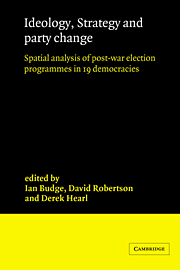 Ideology, Strategy and Party Change
Ideology, Strategy and Party Change Book contents
- Frontmatter
- Contents
- List of Tables
- List of Figures
- Preface
- 1 The influence of election programmes: Britain and Canada 1945–1979.
- 2 The internal analysis of election programmes.
- 3 Britain, Australia, New Zealand and the United States 1946–1981, an initial comparative analysis.
- 4 Canada 1945–1980: party platforms and campaign strategies.
- 5 Sri Lanka 1947–1977: elite programmes and mass politics.
- 6 Israel 1949–1981.
- 7 Ireland 1948–1981: issues, parties, strategies.
- 8 Northern Ireland 1921–1973: party manifestos and platforms.
- 9 Sweden and Denmark 1945–1982: election programmes in the Scandinavian setting.
- 10 The Netherlands 1946–1981.
- 11 Belgium 1946–1981.
- 12 Luxembourg 1945–1982: dimensions and strategies.
- 13 Austria 1945–1978.
- 14 Electoral programmes in West Germany 1949–1980: explorations in the nature of political controversy.
- 15 France 1958–1981: the strategy of joint government platforms.
- 16 Italy 1946–1979: ideological distances and party movements.
- 17 Japan 1960–1980: party programmes in elections.
- 18 Do parties differ, and how? Comparative discriminant and factor analyses.
- Appendices
- General bibliography
- Index
12 - Luxembourg 1945–1982: dimensions and strategies.
Published online by Cambridge University Press: 27 October 2009
- Frontmatter
- Contents
- List of Tables
- List of Figures
- Preface
- 1 The influence of election programmes: Britain and Canada 1945–1979.
- 2 The internal analysis of election programmes.
- 3 Britain, Australia, New Zealand and the United States 1946–1981, an initial comparative analysis.
- 4 Canada 1945–1980: party platforms and campaign strategies.
- 5 Sri Lanka 1947–1977: elite programmes and mass politics.
- 6 Israel 1949–1981.
- 7 Ireland 1948–1981: issues, parties, strategies.
- 8 Northern Ireland 1921–1973: party manifestos and platforms.
- 9 Sweden and Denmark 1945–1982: election programmes in the Scandinavian setting.
- 10 The Netherlands 1946–1981.
- 11 Belgium 1946–1981.
- 12 Luxembourg 1945–1982: dimensions and strategies.
- 13 Austria 1945–1978.
- 14 Electoral programmes in West Germany 1949–1980: explorations in the nature of political controversy.
- 15 France 1958–1981: the strategy of joint government platforms.
- 16 Italy 1946–1979: ideological distances and party movements.
- 17 Japan 1960–1980: party programmes in elections.
- 18 Do parties differ, and how? Comparative discriminant and factor analyses.
- Appendices
- General bibliography
- Index
Summary
THE PARTY SYSTEM
Luxembourg is a small Grand Duchy of approximately 365,000 inhabitants situated between Belgium, Federal Germany and France. Its experience of competitive party politics goes back to the foundation of a ‘Catholic Action Committee’ to contest the 1848 elections in opposition to the then ‘Liberal’ hegemony in Parliament. The first socialist deputy was elected in 1896, while the country's first proper political party, the ‘Social Democratic Party of Luxembourg’, was founded in 1902. By 1914, the forerunners of today's three main parties, one Socialist, one Liberal, and one Christian-Democrat, were all fully organized. Since 1919 they have contested elections on the basis of universal suffrage, and have virtually monopolized Government. Of the others, only the Communists survived as a parliamentary party for the entire post-war period. However, they only participated in government once (the so-called ‘Government of National Union’ from 1946 to 1947). The Christian Social Party, CSV, led every post-war government until 1974; while the other two – the Socialists and Liberals – neatly alternated as the CSV's junior coalition partners in response to their varying fortunes at the polls.
As in Belgium, this deeply entrenched four-party system was rooted in a two-dimensional structure among the electorate which superimposed the newer socio-economic class cleavage upon the older clerical/anti-clerical one which had given birth to the original two-party system. Over the past twenty years, however, two important changes have taken place.
- Type
- Chapter
- Information
- Ideology, Strategy and Party ChangeSpatial Analyses of Post-War Election Programmes in 19 Democracies, pp. 254 - 269Publisher: Cambridge University PressPrint publication year: 1987
- 1
- Cited by


